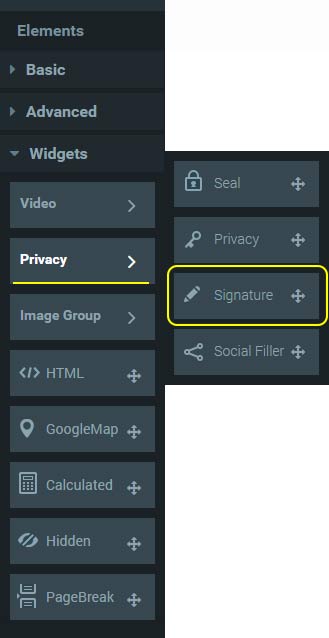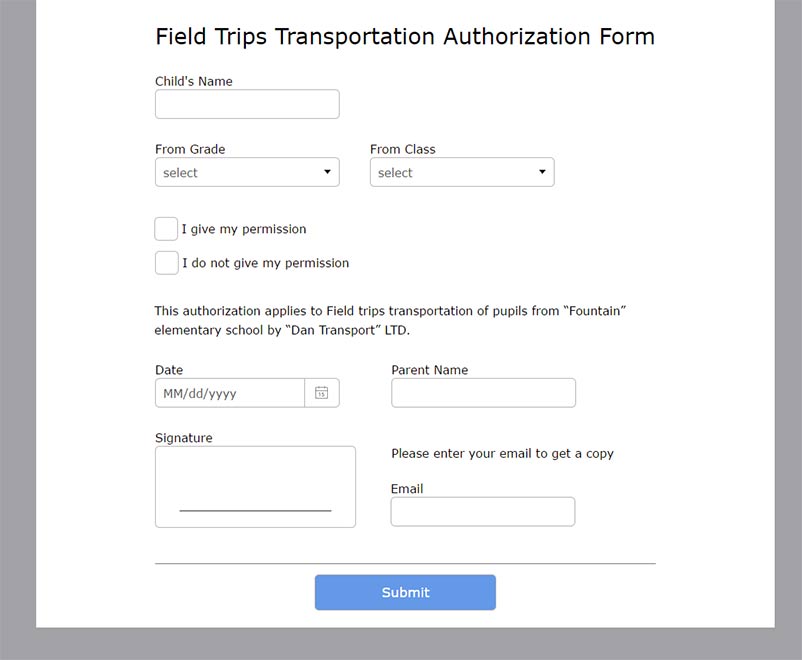Using digital signatures in your online forms, the easy way!
Using digital signatures in your online forms, the easy way!

The Digital Signature
Many organizations, businesses and companies have to use signatures as part of their business processes. It can be used to get a customer’s consent, to get a manager’s approval, or to get a sign of obligation. The signature can be used in many different cases.
Since many businesses still use paper forms, getting them signed means printing them out, signing them by hand and faxing them back.
Interestingly enough, In businesses that do use online forms instead of hard copy ones the electronic chain is often broken in order to add a signature to the digital form and this reduces efficiency.
The benefits of adopting electronic signatures are obvious: why use paper forms, which take up space, are not cost effective, are easily damaged or torn, can be misplaced, require delivery, cannot be easily edited, may lead to mistakes, not mentioning the environmental issue.
E-signatures are used nowadays in all types of business documents. Ranging from simple service contracts to complex real estate transactions.
And with cloud based tools becoming so popular, online forms, containing electronically signed documents are now becoming standard operating procedure.

Is it actually legal?
There seems to be a lot of confusion going on about digital and electronic signatures. so just to get things clear - Digital signatures are legally binding, while Electronic signatures are used to collect signatures as approvals, that do not need to hold up in court.
Christopher Null makes a really good point in his post E-signatures: The complete guide to paperless signing
when he asks if using digital signatures is legal. He says “It sure sounds fast and convenient—and it beats the heck out of dealing with registered mail—but are e-signed contracts legal? Will they hold up in court the same way an ink-stained piece of paper will?” the answer according to Mr. Null is yes. With the exception of wills and promissory notes or in a nutshell -anything that requires notarization.
Digital signatures are considered legally binding in almost all countries and states, but it is still recommended to consult with a lawyer regarding the legal aspects before you use them..
The need for digital signatures has led to many cloud based services to pop up, and provide an easy way to sign documents. However this solution is very specific and limited to e-signing .
Digital signatures in online forms
But what if you want to collect more than just signatures? What if you need to use an online form and you want to have it signed? can you incorporate an electronic or digital signature in it? Well...it seems that this can easily be achieved with an online form builder. Standard elements like textboxes, radio buttons or checkboxes are easily found in all form builders, but special elements like signatures are not always available, and Digital signatures that hold up in court are scarcely found in these tools - so be sure to check which form builder possesses the elements you need.
Another issue you need to make sure of is that the online form has responsive design capabilities. The signature element needs to be available for all devices, allowing visitors to sign your form touch-screen devices, touch pads or mouse.
Signature element located under "Widgets" in FormTitan form builder- simply need to drag it to the canvas

How simple is it to create an online form with a digital signature?
When it comes to form builders simplicity is the name of the game. Dragging & Dropping elements one by one onto the canvas, placing them where you want, configuring their settings and making the form attractive with styles and graphic elements - That’s all it takes really. Take FormTitan, for example,
Adding a signature to your form with this form builder is easy - all you need to do is go to the “Elements panel”, choose the “Widgets” category, “Privacy” sub category and drag the “Signature” element. Once on canvas you can change the signature size, border, back color etc.
Following is a screenshot of a form that contains the signature element.
Click to open the live form online.
Once a form filler enters his signature in your form it is saved as an image file and stored in your FormTitan account.
Read more about the difference between digital and electronic signatures






